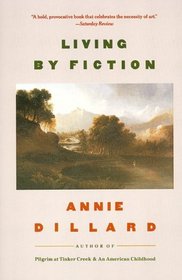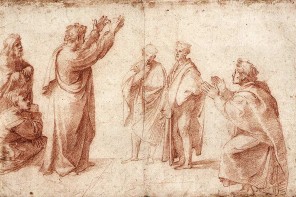 Last autumn in the most unlikely of places—an academic conference in Oxford—I was reminded of the redemptive theological potential of the arts. In the discussion following my paper on kenotic images of God in Annie Dillard’s book, Holy the Firm, a woman courageously risked moving the conversation from academic to personal grounds. Her mother, she told us, has Alzheimer’s. In her search for meaning in the midst of their suffering, she found little consolation in an omniscient and omnipotent God. But Dillard’s poetic rendering of an eternally crucified Christ who suffers alongside us had touched her deeply, and its symbolic language suddenly awakened in her the knowledge and concomitant consolation that a self-emptying God also weeps beside a mother being more emptied of herself each day. Poetry carried God to this daughter that afternoon.
Last autumn in the most unlikely of places—an academic conference in Oxford—I was reminded of the redemptive theological potential of the arts. In the discussion following my paper on kenotic images of God in Annie Dillard’s book, Holy the Firm, a woman courageously risked moving the conversation from academic to personal grounds. Her mother, she told us, has Alzheimer’s. In her search for meaning in the midst of their suffering, she found little consolation in an omniscient and omnipotent God. But Dillard’s poetic rendering of an eternally crucified Christ who suffers alongside us had touched her deeply, and its symbolic language suddenly awakened in her the knowledge and concomitant consolation that a self-emptying God also weeps beside a mother being more emptied of herself each day. Poetry carried God to this daughter that afternoon.
Annie Dillard in Living By Fiction argues that artistic symbols are not merely a mimesis of the world’s mysteries but “actually [penetrate] them” opening up “new and hitherto inaccessible regions.”[1] These structures of symbols “can render intelligible—or at least visible, at least discussible—those wilderness regions which philosophy has abandoned and those hazardous terrains which science’s tools do not fit. I mean [ . . . ] all those areas of human experience, feeling, and thought about which we care so much and know so little.”[2]
Of course, art is not salvific; only Christ is. But the epistemic potential of the arts has a redemptive theological dimension in its healing ability to order disorienting experiences and embody meaning in the midst of meaninglessness. We claim as Christians to live an embodied faith in an incarnate God. Yet how does one understand that claim when the body turns renegade and its own cells murderous? When a chromosome snaps and a child’s limbs wither? Literary symbols enable one to enflesh a self whose integrity resides within the structural universe of symbolic language rather than (or solely) within muscle and bone. It thus can momentarily liberate the sufferer from the isolation, silence, and immobility the body imposes. Lines become limbs, whole and lithe, unfettered by sickness. Words create a voice, resonant and clear, unpinched by pain.
In doing so, the literary arts can become vehicles of revelation and liberation for both writer and reader. As poetry therapist John Fox explains, “[t]his moment of surprising yourself with your own words [ . . . ] is at the heart of poetry as healer. Surprise is a kind of revelation, resurrection and rebirth—a creative, joyful, luminous, physical experience of being disinterred from limitation.”[3] The most inexorable of limitations is death. Even then, however, words can allow the bereaved to receive back their loved ones through memories embodied in symbolic structures. While conducting a writing workshop for a bereavement group recently, I witnessed the beautiful irony that writing helped members both comprehend their loss and regain, in part, what they had lost. The remarkable stories that emerge from programs such as the Arts in Medicine (AIM) initiative begun in 1990 at Shands Hospital at the University of Florida[4] also demonstrate the power of the arts to embody and thus make “at least visible, at least discussible” the “wilderness regions” [5] of our humanity, particularly when our creatureliness is foregrounded by sickness, pain, and death.
In short, the redemptive theological potential of poetic language rests in its ability to transpose the chaos of suffering into an ordered symbolic structure, a structure that liberates us to inhabit and redeem our experiences within a new body, a corpus of signifiers.
Lori Kanitz is a Ph. D. candidate in Divinity at the Institute for Theology, Imagination, and the Arts at the University of St. Andrews, Scotland, as well as an Assistant Professor of English at Oral Roberts University in Tulsa, Oklahoma. Her dissertation examines ways Jewish mystical thought, particularly Hasidism, emerges in the work of American author Annie Dillard.
[1] Annie Dillard. Living By Fiction (New York: Harper & Row, 1982), 167.
[2] Ibid., 170.
[3] John Fox. Poetic Medicine: The Healing Art of Poem-Making (New York: Putnam, 1997), 3.
[4] “Shands Arts in Medicine,” UF & Shands: The Science of Hope, 1998 – 2011, http://shands.org/aim/.
[5] Annie Dillard. Living By Fiction (New York: Harper & Row, 1982), 170.




Lori, thank you so much for this post! There is a great deal about it that I find fascinating, and I am not sure where to start. I especially love your quote from John Fox: “this moment of surprising yourself with your own words…” What a lovely way to think about writing, or about any form of artistic creativity, and this is such an intriguing perspective from which to think about art and therapy.
Your post also reminds me of one of the James Gregory Lectures this year (perhaps you were there?). A neuroscientist spoke about the way that the brain is not only alterable on a molecular level, but that it is important for the treatment of some illnesses (such as depression) to address macro-level aspects (such as concepts, feelings, ideas, etc.). He suggested that there is a continuum of ways that one can intervene and treat those who suffer from a mental illness, and that the macro-level treatments are not reducible to the drugs that alter brain chemistry on a much smaller level. This idea of transposing our suffering into an ordered symbolic structure would seem to be one very macro level way of working through and healing psychological trauma. It seems to me that this relationship between art and therapy you are pointing to attests profoundly to (what I think is) a human need to inhabit a story, or a whole that brings meaning to the disparate parts of our lives.
I do have one question about this ordered symbolic structure. There is a great deal of negative criticism regarding the so called “meta-narratives” that humans construct for themselves. Orienting one’s self within an ordered symbolic structure may be helpful for one’s one healing and sense of identity, but what happens when that ordered symbolic structure implicitly (or explicitly) excludes, disparages, or leads to suffering for others? The potential dangers of an ordered symbolic structure are all too apparent in the atrocities caused by Nazi Germany. Do you think the answer to these problems is to find private ordered symbolic structures, or are these structures something inevitably public? Also, should we consider these literary symbols in a purely pragmatic way (i.e. they are useful to us in our time of suffering) or by grabbing hold of them, and committing ourselves to them, do we also make larger commitments about the way the world is? I know these are rather big questions, and they take your post beyond its main topic, but I welcome any thoughts you have. Thanks again!
Thanks, Jim, for your perceptive comments and questions. They clarified my own thinking. I’d like to approach possible answers by way of a recent conversation. A very close friend of mine was diagnosed with cancer in early September of last year and has spent the last nine months going through chemotherapy and surgery. When I spoke with her last week, she made the comment, “It is so strange to be in a body I don’t even recognize.”
Once again, I was stuck by the question of how does one construct or reconstruct an embodied identity when the body becomes “other” through illness or disease? In most cases, the meta-narrative we inhabit in an effort to redeem the body or re-inhabit another type of body isn’t created ex nihilo but arises out of an already-existing worldview or meta-narrative. Whatever form of art we choose, it inevitably incarnates both the presuppositions we had prior to the experience as well as the struggle to revise those presuppositions in light of it. In the case of my friend, the overarching narrative of her belief in God is in some ways the same story she inhabited prior to cancer, but it has also undergone such radical revisions as to be entirely rewritten. The Lord of her life seems so different—both more inscrutable and more faithful—now that her body is so different. So, in response to your questions about whether in committing ourselves to symbolic structures we aren’t making larger commitments about the way the world is, I would suggest we’ve already made those commitments; the structures reflect and reinterpret them for us. They simultaneously arise out of our worldview and challenge it.
As you were right to point out, if those beliefs are pathological, ordered symbolic structures can be merely vehicles for inflicting that pathology on others or reinforcing it within oneself. It is entirely possible that a person could become more entrenched in grief rather than guided through it by writing. Or, to use your example, an entire government can embody a toxic ideology as happened in Nazi Germany.
So by all means one should qualify claims about the therapeutic potential of art. But the kind of experience I am trying to speak of and understand seems to have an entirely different quality, alluded to by John Fox. If we come to the creative process open and honest, it can be a means of discovery, of revelation. There is a cognitive and spiritual humility in such an endeavor that allows an in-breaking of something from the outside, as it were, that is both familiar and surprising. The sort of vehicle, or ordered symbolic structure, employed to victimize or control others, however, aims to cut off cognitive and spiritual openness and is therefore perhaps better understood as propaganda. I know I’m making huge generalizations that lead to further questions about utilitarian aspects of art, differences between art and propaganda, and so on, but those will have to wait for another conversation! To sum up, I agree that caution is warranted. Art can just as easily become the means of reinforcing pathologies as it can be the way of liberating someone from them. But if the creator starts from the question (as Dorothy L. Sayers suggests in “Toward a Christian Aesthetic”), “how can I truthfully render my own experience?” rather than “how can I produce an emotion in myself or others?” or “how can I get others to do and feel what I want?” those risks are minimized.